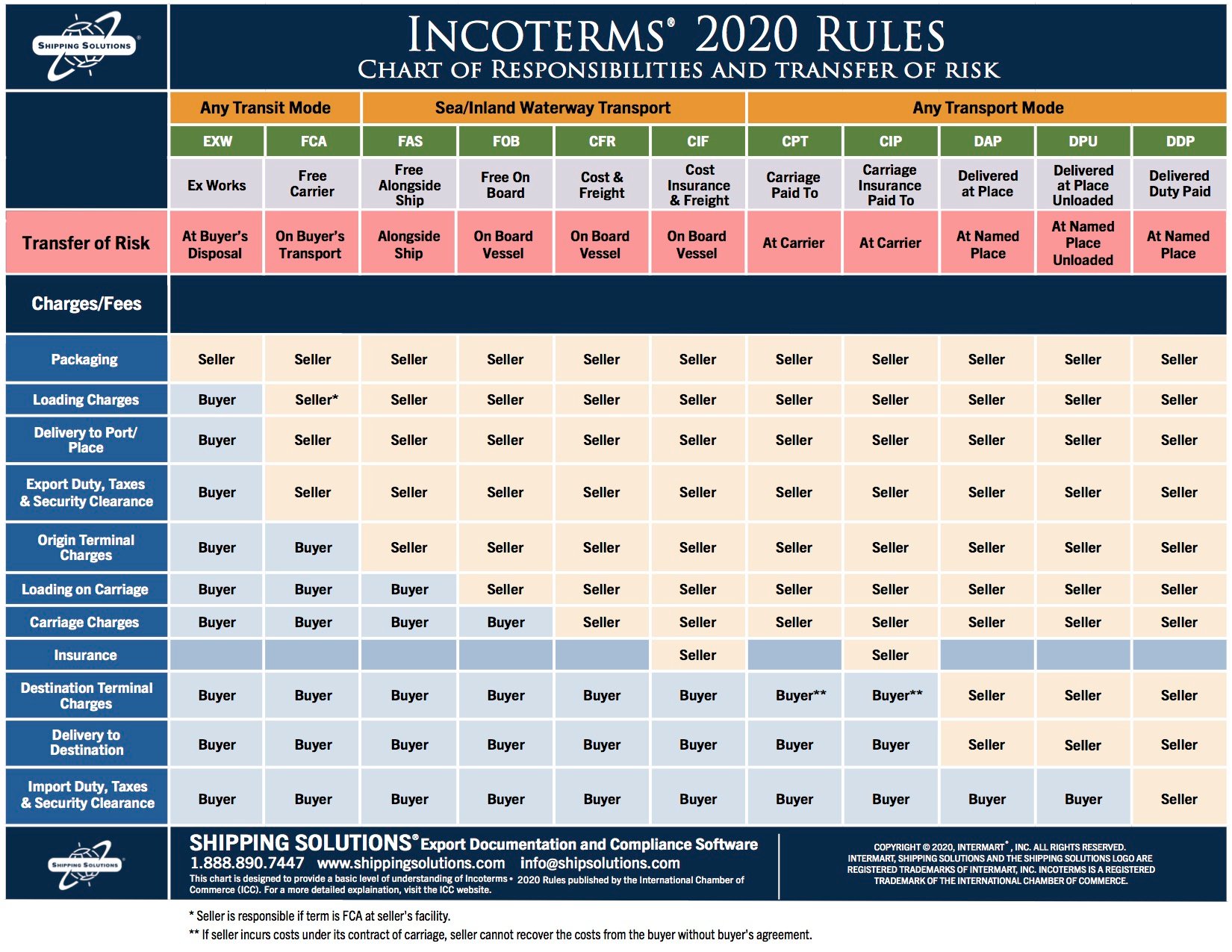The International Trade Blog International Sales & Marketing
Incoterms Comparison: DDP vs. DAP—What's the Difference?
On: March 20, 2024 | By:  David Noah |
7 min. read
David Noah |
7 min. read
 The Incoterms DDP and DAP are very similar: Both deal with all types of transport, and both have similar timelines for the point at which risk and liability pass from seller to buyer. For these reasons, exporters may confuse the two. In this article, I’ll define DDP vs. DAP and share the differences between the two, so you can make an informed decision on which term is the best choice for moving your goods.
The Incoterms DDP and DAP are very similar: Both deal with all types of transport, and both have similar timelines for the point at which risk and liability pass from seller to buyer. For these reasons, exporters may confuse the two. In this article, I’ll define DDP vs. DAP and share the differences between the two, so you can make an informed decision on which term is the best choice for moving your goods.

Delivered Duty Paid (DDP): A Definition
Delivered Duty Paid (DDP) means the seller bears all risk and costs associated with delivering goods to the named place of destination ready for unloading and cleared for import. This Incoterm places the most responsibility and risk on the seller.
DDP Responsibilities and Transfer of Risk
Under the Incoterms 2020 rules, DDP requires the seller to:
- Take responsibility for clearing the goods for export.
- Bear all risks and costs associated with delivering the goods.
- Unload goods at the terminal at the named port or place of destination.
- Clear the goods for import and payment.
- Bring the goods to the place of destination.
With DDP, the seller is also obliged to pay all import duties, the required Value Added Tax (VAT) and other taxes, and execute all customs formalities. This is extremely risky for the seller, because they may not be fully aware of the import clearance procedures in the country of import or how to find a competent local customs broker. The seller must also deal in a foreign currency, which means they are responsible for the currency exchange and its associated risks.
Because of this, the seller may want to use the term Delivered at Place (see below) or Delivered at Place Unloaded (DPU).
With DDP, risk transfers to the buyer at the destination, so the destination should be stated clearly and precisely in all documentation.
DAP (Delivered At Place): A Definition
Delivered At Place (DAP) means the seller is responsible for all charges and risks in transit until the goods reach their destination (at a named place).
DAP is a flexible term ideal for use in multimodal transport: The named destination could be a port, airport, seaport, the buyer's premise or a border crossing. It does not need to be a freight destination; any named place will work as long as it's a foreign destination or a border crossing.
DAP may sound similar to CPT (Carriage Paid To), but its flexibility is one of the primary differences. The other difference is that under DAP, the risk of loss stays with the seller until the goods arrive at the named place.
DAP Responsibilities and Transfer of Risk
Under the Incoterms 2020 rules, the buyer is responsible for all costs and risks associated with unloading the goods and clearing customs to import the goods into the named country of destination. The buyer selects a customs broker and is responsible for entry fees, duties, taxes, inspection fees and storage fees if goods are not released in a timely manner. The seller must coordinate with the buyer's customs broker to provide any documentation required for export clearance.
The seller is not required to unload goods unless specified. However, if the seller’s contract of carriage includes unloading the goods at the place of delivery, they may not recover that cost from the buyer unless agreed upon by the buyer.
With DAP, cost and risk transfers from seller to buyer at the point the goods are available for unloading.

The main difference between DDP and DAP is delivery to destination and who is responsible for import duty, taxes and security clearance.
Under DDP, the seller assumes the maximum responsibility in costs and risk from the beginning to the end. Under DAP, the buyer bears the costs and taxes of import clearance.
With DAP, the buyer is responsible for unloading the goods at the final destination.
With both DAP and DDP, the transfer of risk occurs at a named place.
DDP vs. DAP: Which Should You Use?
Because of the complex bureaucracy of import clearance procedures, the level of risk in hiring customs brokers in destination countries, and a potential lack of knowledge around current import duty rates and rate changes, DDP is an extremely risky term for the seller to choose. Exporters should be wary of using it. If you do decide to use DDP, consider this adjustment to mitigate some of the risk that comes with hard-to-estimate taxes: "DDP (named place of destination) excluding VAT or other taxes."
DDP may also have questionable value to importers, since they must depend on the seller to successfully navigate these challenges.
Using the Incoterm DAP is a preferred choice for the exporter who wants more control over freight but does not want to be involved in import taxes and duties.
DDP and DAP Frequently Asked Questions (FAQs)
-
What are the risks for sellers when using DDP?
The primary risk for sellers who use DDP is the complexity of import clearance procedures. Finding reliable customs brokers in destination countries can be difficult, and sellers may not have a good understanding of import duties.
-
What are the risks for buyers when using DAP?
Buyers using DAP are responsible for unloading the goods at the named place of destination and clearing customs for importation. They need to ensure they have the necessary resources, including a competent customs broker, to handle import procedures, entry fees, duties, taxes, inspection fees and potential storage fees if goods are not released promptly.
-
Can sellers choose DAP instead of DDP to reduce risks?
Yes, sellers who want more control over the shipment and to avoid the complexities and risks associated with import duties and taxes often prefer DAP over DDP. By selecting DAP, sellers can still oversee the transportation process while shifting the responsibility for import clearance to the buyer.
-
Which party is responsible for insurance under DDP and DAP?
Under both DDP and DAP, the seller is not obligated to provide insurance coverage for the goods. However, it is recommended for both parties to agree on insurance coverage to protect against loss or damage during transit.
-
Are DDP and DAP suitable for all types of shipments?
DDP and DAP can be used for any mode of transportation (DAP is ideal for us in multimodal transport), but they may not be suitable for every situation. Consider the nature of the goods, the destination country's customs regulations, and the parties' capabilities and preferences when choosing an Incoterm.
-
Can the seller choose between DDP and DAP?
Though the seller often proposes the Incoterm to use, it is essential to consider the buyer's preferences and the specific requirements of the trade transaction. Both parties should agree on the chosen Incoterm to avoid misunderstandings or disputes.
-
Are DDP and DAP suitable for both international and domestic shipments?
For companies in the United States, Incoterms—including DDP and DAP—are primarily used for international trade. Terms defined under the Uniform Commercial Code are more commonly used domestically. However, there is no reason that Incoterms can't be used for a domestic shipment as long as both parties agree to the use of the term chosen. In other regions of the world, Incoterms are more commonly used for domestic shipments. When used domestically, there are some responsibilities defined under each of the terms like customs clearance that are simply ignored because they don't apply.
-
Who is responsible for arranging customs clearance under DDP and DAP?
Under DDP, the seller is responsible for arranging and covering the costs of customs clearance in the buyer's country. Under DAP, the buyer is typically responsible for customs clearance.
-
Can the buyer request additional services or modifications under DDP and DAP?
DDP and DAP define minimum obligations and responsibilities of the seller and the buyer. Additional services or modifications beyond these terms can be negotiated between buyer and seller. It's important to clearly document any additional agreements or requirements in the sales contract to avoid misunderstandings.
Learn More about Incoterms 2020 Rules
If you are regularly involved in international trade, you need to understand the risks and responsibilities as defined by Incoterms 2020 rules, not just pick the term you always use. Start by getting a copy of ICC's Incoterms® 2020 Rules book.
For a more detailed understanding of which term or terms make the most sense for your company, register for an Incoterms® 2020 rules seminar or webinar offered by International Business Training. You can also read our articles about each of the Incoterms 2020 rules here:
- EXW (Ex Works)
- FCA (Free Carrier)
- FAS (Free Alongside Ship)
- FOB (Free On Board)
- CFR (Cost and Freight)
- CIF (Cost, Insurance and Freight)
- CPT (Carriage Paid To)
- CIP (Carriage and Insurance Paid To)
- DAP (Delivered At Place)
- DPU (Delivered At Place Unloaded)
- DDP (Delivered Duty Paid)
Like what you read? Subscribe today to the International Trade Blog to get the latest news and tips for exporters and importers delivered to your inbox.

About the Author: David Noah
As president of Shipping Solutions, I've helped thousands of exporters more efficiently create accurate export documents and stay compliant with import-export regulations. Our Shipping Solutions software eliminates redundant data entry, which allows you to create your export paperwork up to five-times faster than using templates and reduces the chances of making the types of errors that could slow down your shipments and make it more difficult to get paid. I frequently write and speak on export documentation, regulations and compliance issues.

